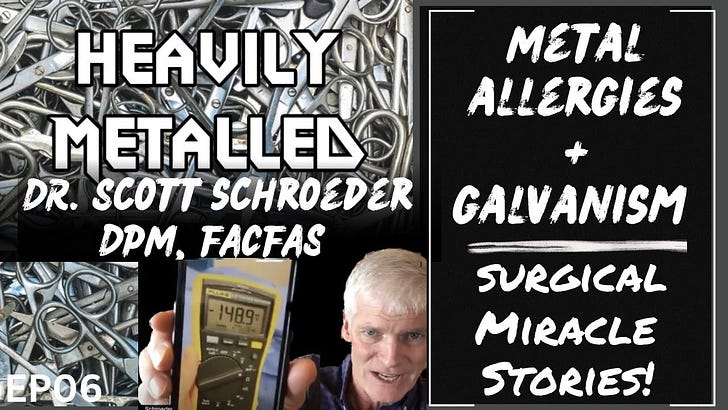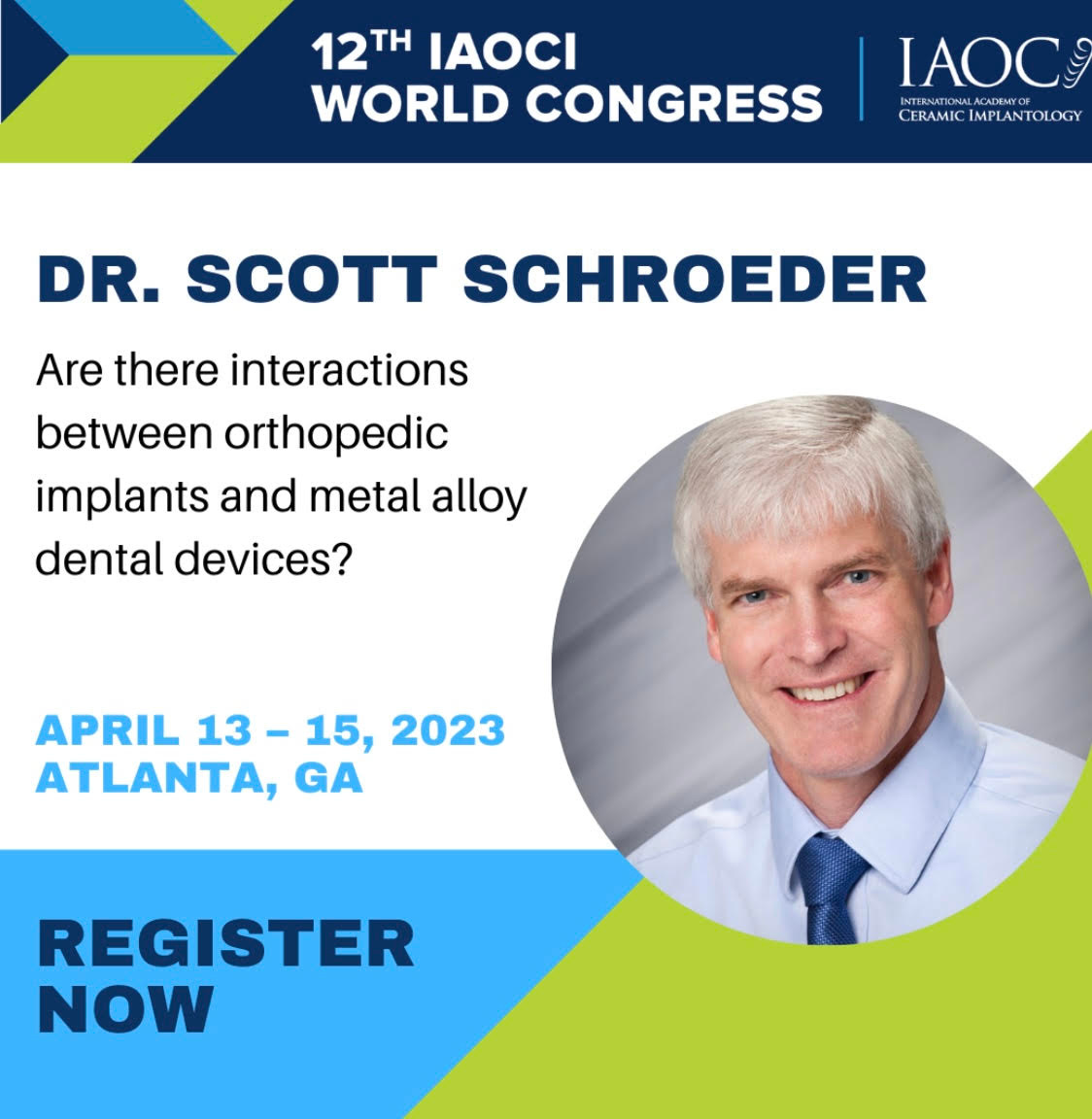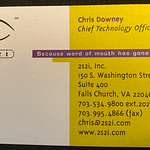By Robert Yoho and Deborah Butler (The World Has Gone Mad Substack). Our dental episode HERE is valuable background.
Dr. Schroeder's interview includes patient audio testimonials. He wrote:
I have placed thousands of metallic implants in my patients over my 30-year foot and ankle surgeon career. I didn't ask many questions about metal allergies or reactions earlier in my practice. It wasn't until my partner placed titanium alloy screws in my wife during bunion surgery that I started paying attention.
After the surgery, she had burning, shooting pains every night for about four months and could not put her foot under the covers. She would go to bed with an ice pack to get her foot calmed down to try to sleep. When the hardware was removed, the pain went away. This was 16 years ago, and it opened my eyes. We learned subsequently that my wife was allergic to aluminum and nickel. The titanium screws also contained vanadium, aluminum, and a trace amount of nickel.
In 2019, I presented "Systemic Effects of Metal Allergies" to the FDA. My cases included an engineer in his forties who became paralyzed for 10-12 hours per day shortly after I placed eight 2.0 mm screws in his feet. When he returned for another issue about four years later, I operated on one of his feet and noticed swelling where the screws were. So I removed them because of a possible nickel allergy.
When the patient returned for his second post-op visit, he finally told me his paralysis story. He said he had been immobilized for over ten hours a day, but immediately after the screws were removed, the pattern decreased to three hours a day. He had been seen at Mayo Clinic several times, and they told him, "Sorry, you are just going to be in a wheelchair the rest of your life, and eventually, your wife will have to put you in a nursing home." I sent his blood to Germany to test for metal allergies with the "MELISA-optimized lymphocyte transformation assay." I was already working with Dr. Vera Stejskal, the Swedish immunotoxicologist who invented the test.
This showed that the engineer was allergic to nickel and palladium. We learned that the gold crowns in his mouth were 26% palladium and that he also had a titanium screw in his knee. When we removed the screw from his knee, he had a minor improvement, but the day his last gold crown was taken out of his mouth, his paralysis disappeared and has not recurred. That was several years ago.
I have many other stories about patients who have had stunning health improvements after I removed metal from their bodies. And I had placed most of it!
I have been presenting around the world about this since 2015. I have lectured in Australia, New Zealand, London, Turkey, and the US. I have learned from many top researchers and physicians. When I presented in London, the Queen's Orthopedist who lectured after me bought my wife and me drinks that night.
Before Dr. Stejskal passed on from breast cancer, she had been working with European surgeons and dentists. They had many cases where chronic pain associated with a total hip or knee would go away after the removal of dental metals. I was intrigued but skeptical, so I started paying more attention to my cases and asking more questions about patients with multiple metals in their bodies. I began seeing patterns.
To learn more, I am working with engineers who specialize in "body galvanic corrosion." Yesterday the ethics committee approved our study on explanted materials associated with the various symptoms. It is a combined effort of the University of Victoria and the University of British Columbia. I am an adjunct faculty member working with a professor at the University of Victoria.
Scott describes two different problems:
metal allergy to orthopedic devices
metal orthopedic implants causing dental amalgams to release toxic mercury through a battery effect.
Implants, particularly orthopedic ones, are ubiquitous. The most commonly recognized allergies to their components involve nickel, cobalt, chromium, and bone cement. Practicing orthopedists such as my co-interviewer Jeff Martin and MR, another senior orthopedist, have vast experience and say they are rare. MR adds:
I do see metal allergies from time to time. We get an allergist involved before or after as required. I don't have any dramatic cures effected by metal removal or severe symptoms like paralysis. We don't know how common these allergies are. I recognize them seldom, and it is usually the patient who thinks or asks about that possibility.
Checking for allergies. Sending blood to Germany for the MELISA test is unnecessary. Any allergist can place skin patches that have these substances on them. If a rash is seen when they take these off a few days later, the patient is allergic to whatever is on the patch. Nickel allergy is the most common; five to twelve percent of the population has it. Taping a nickel coin to the inner thigh and checking for a rash in a day or two is a simple test for this.
Testing for mercury toxicity. Some practitioners use blood, urine, breath, hair, saliva, and even stool analysis. For chronic exposures—which are the majority—these are usually negative and an unneeded expense. Instead, most authorities remove amalgams and possibly orthopedic devices. If the patient improves, that is all anyone cares about.
Treatment for mercury toxicity. For very high levels, such as might occur in a poisoning, chelating agents such as Dimercaprol (BAL) bind the mercury and facilitate urinary elimination. These are usually given intravenously. They are rarely necessary for chronic cases because if the exposure stops, the body gradually clears the toxin. The symptomatic improvement can be dramatic.
Reference: Mercury-Free: A clear path that guides you and our planet back to good health by Teresa Franklin PhD and James Hardy DMD (2021)
My coauthor Deb has health issues that may be related to metals:
In February 2014, I had my right knee replaced. I was walking with a cane on the third day following surgery, and my tibia split from the knee down. The surgeons then inserted a metal rod. After that, I needed a walker everywhere I went.
In June 2021, our vehicle was hit by another car, and my right femur fractured just above the knee. The surgeons placed a second rod in my leg and did a total knee replacement. The next day, I could walk up and down steps for the first time in seven years. For 2 1/2 months, I had a spectacular recovery, but I developed an abscess in the anchor tooth of a three-tooth permanent bridge.
I had a root canal, but it has been downhill ever since. I have had pins and needles and loss of feeling in both legs. Walking is difficult. I have lost most feeling inside my mouth. I have joint pain, and 90% of my hair has fallen out. I spent tens of thousands of dollars on functional doctors, naturopaths, and holistic physicians without improvement.
In April 2023, I read Dr. Yoho's Substack post about metals in vaccines. Mark Kennard from New Zealand wrote a comment about his experience with metal implants in his body, and his experiences sounded similar to mine. When I spoke to him, he referred me to Scott Schroeder, a Washington state orthopedist who discovered that the metals he implanted into his patients were making some of them chronically ill. Dr. Schroeder was kind enough to speak to me for over an hour, and I realized that I had likely been suffering from metal reactions since 2014.
I plan to remove as much metal as possible from my body, starting with my mouth. I will report what happens as I go through the process.
To be continued.
References
1.
2.
Dental amalgam restorations are over fifty percent mercury. HERE is how dentists can remove them safely. From the website:
Reports and research are consistent that these fillings emit mercury vapors.2-16 Research demonstrates that dental mercury amalgams expose dental professionals, dental staff, dental patients, and/or fetuses to releases of mercury vapor, mercury-containing particulate, and/or other forms of mercury contamination.4-48 Mercury vapor is released from dental mercury amalgam fillings at higher rates during brushing, cleaning, clenching of teeth, chewing, etc.,5, 14, 15, 24, 30, 49-54 and mercury is also known to be released during the placement, replacement, and removal of dental mercury amalgam fillings.2, 25, 28, 29, 32, 36, 41, 45, 46, 55-60
Their recommendations include the following:
Systems to dispose of the toxic waste
Elaborate gowns, drapes, and oral barriers during the removal
Oxygen and positive pressure air systems for patient and dental personnel
Face shields/hats/special gloves/properly-sealed, respiratory-grade masks
Suction and irrigation
I do not envy these people. They work in a profoundly toxic environment.
This downloadable PDF is about blood testing for metal allergies:
The Cassandra's Memo ebook is free HERE if you promise to send the download link to five or more others. Hard copies are available at Barnes and Noble. With your help, we will educate some people sitting on the fence. If you have time to write a review at Barnes and Noble, click HERE and scroll down the page until you see the blue “review” button on the right.
BONUS: I am also giving away the Hormone Secrets and Butchered by "Healthcare" ebooks using the same arrangement. You may download them free HERE and HERE if you promise to send the links to your friends. Hard copies of these are available at Amazon.
I have no copyright; you may (accurately) quote any of my essays or books in part or whole without restriction.
Substack love. Thanks for your help.














Share this post